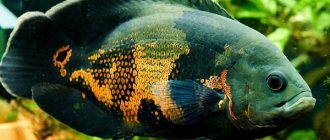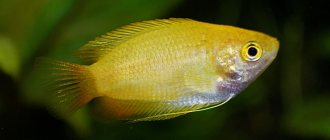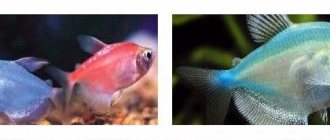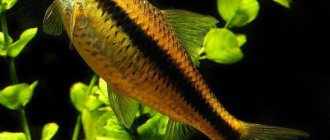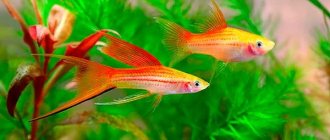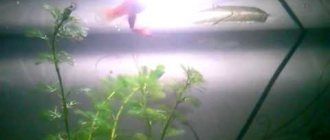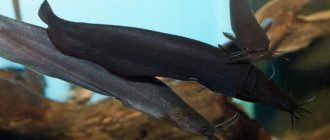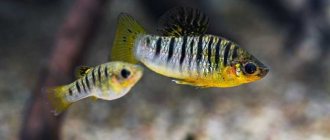Swordtails
Simplicity of content:
Latin name: Xiphophprus helleri
Lifespan: 5 years
Maximum size: 8 cm.
Average cost: 30-150 rubles.
The nimble swordtail fish with an unusual appendage on its tail gives its owners aesthetic pleasure when contemplating, observing their habits, and way of life. An unpretentious aquarium fish, thanks to its diversity of species, colors the underwater world with bright colors and gets along well with its neighbors.
Compatibility of Swordtails
Swordtails are non-aggressive. They are compatible with almost all small peaceful fish. Among the best neighbors are tetras , minors , thornets , zebrafish , all poeciliid fish , etc. They are compatible with almost all bottom fish: corydoras , acanthophthalmus , platidoras , ancistrus , etc. They get along well with “peaceful” cichlids, for example, with angelfish .
Swordtails are incompatible with aggressive and large fish that will hunt them, for example, cichlids (acaras, astronotuses, diamond cichlids, etc.). In addition, it is not recommended to add them to “veiled” fish, because the latter are slow and swordtails can “pinch” them by their fluttering fins.
Male swordtails show some intolerance and aggression towards each other. There have been cases of males fighting, even to the point of causing damage to each other. Therefore, in an aquarium, swordtails should be kept in a harem, so that there are 2-3 females per male. In this case, the intraspecific aggressiveness of the fish is noticeably reduced. See the article on aquarium fish compatibility.
Health
If kept inappropriately, swordtails' immunity weakens. If a white dotted coating, similar to semolina, is found on the body and fins, it means that the body of the fish is parasitized by ciliated ciliates - the distributor of the disease ichthyophthyriosis. The pathogen enters the aquarium with live food and bottom flooring.
An unhealthy fish changes behavior and exhibits characteristic symptoms:
- the swordtail presses its fins to its body and rubs against the pebbles;
- at a late stage of the disease, the fish eat poorly and, due to lack of oxygen, swim closer to the surface;
- ulcers that quickly increase in size form on the gills, fins, and sides;
- scales fall off, skin peels off.
At the first signs of ichthyophthyriosis in fish, they do a general cleaning of the aquarium. Drugs are added to the water following the instructions. At the initial stage of swordtail disease, Sera Omnisan is effective, in advanced cases - JBLPunktolULTRA. Table salt and raising the water temperature only help with a simple, non-mutated infection. Get rid of white plaque on the body of fish and fins by adding 5 drops of iodine per 100 liters of liquid. It is effective to add 1 tablet of furatsilin per 10 liters to the aquarium, dissolved and mixed with malachite organic dye.
The antibacterial drug Omnisan can be purchased in various quantities.
Swordtails are susceptible to the parasitic disease chylodonellosis, which is manifested by loss of appetite and a matte gray-blue coating under the fin on the back. Infected fish are removed and treated with salt baths or Nilpa Aquaform, Omnisan.
Fish that have not passed quarantine are affected by fin rot in the aquarium, in which a gray rot in the form of a rim forms on the tail and dorsal fin, devouring the flesh. Methylene blue, diluted to a light turquoise color, solves the problem.
Minimum aquarium volume for swordtails
Many novice aquarists keep swordtails in small aquariums. However, this is not entirely correct. In fact, swordtails are quite large fish. And taking into account the fact that it is recommended to keep swordtails in the proportion of 1 male to 2-3 or more females, the minimum size of the aquarium for them should be from 50 liters per harem family. The aquarium for swordtails should be spacious, it is better to take 100 liters.
Find out how many fish you can keep in X liters of aquarium HERE (at the bottom of the article there are links to aquariums of all sizes).
Appearance, behavioral factors
In nature, swordtails, of the poeciliaceae family, are not so attractive. The natural gray-green color has changed, as a result of selection, to bright rainbow colors. The aquarium fish has a length of elongated, laterally flattened body of 7–8 cm, which is 4 cm less than the size of swordtails that live in natural reservoirs.
What does a swordtail look like? Let's look at a classic example: a tail with a xiphoid process, a dense body elongated in length, a large mouth directed upward.
The original appearance is given by the tail fin, the lower part of which is elongated into a sharp ray or a sword rounded at the end. The mouth of the fish is shifted upward, making it convenient for the swordtail to collect food from the water surface. Viviparous females are slightly larger than males, paler in color and without a tail appendage. The lifespan of fish is limited to five years.
Despite their peaceful nature, in order to avoid fights, more than three males are not kept in one aquarium.
When the conditions of detention change or there are no males in the flock, female swordtails grow a characteristic sword on their tail in several stages, and later the copulatory sexual organ of the gonopodium is formed. Females turn into males in exceptional cases to preserve the population. There is no reverse degeneration of the fish.
Care requirements and conditions for keeping swordtails
Swordtails do not need any special conditions. In fact, maintaining optimal aquarium water parameters is the key to their well-being. However, do not forget that:
1. Swordtails definitely need aeration and filtration, weekly replacement of up to 1/4 of the volume of aquarium water. It is worth noting that these fish do not need a lot of oxygen, and too frequent changes (replacement) of aquarium water are not as beneficial for them as for other types of aquarium fish. Therefore, if you change the water less often, for example, once every 14 days, and not every 7, nothing bad will happen. This rule is appropriate with a stable biobalance and zero nitrogen: NH4, NO2, NO3.
As with any other fish, high concentrations of poisons are unacceptable: ammonia, nitrites and nitrates . Every conscientious aquarist should always have a set of drop tests on hand, at least for nitrate and phosphate. Fortunately, they have now become inexpensive, there are no problems with their assortment and acquisition. For example, we can with a clear conscience recommend you the cool UHE drop tests, , but they are sold only online. In stores in your city - offline, you can find inexpensive Vladox tests . Friends, watch out for nitrogen compounds, keep them in check and everything will be fine for you and your pets.
It would be useful to use clean water supply for deep water changes and use preparations that neutralize harmful substances. For example, Tetra AquaSafe - it removes chlorine compounds, heavy metals + contains B vitamins, iodine and other aquarium goodies.
2. The aquarium must be covered with a lid, because The fish are nimble and can jump out and die.
3. Like many fish, swordtails feel comfortable among vegetation. Vallisneria , Echinodorus , Cryptocoryne , Riccia , duckweed as aquarium plants for them . Creating thickets of plants imitates the natural habitat of fish.
4. When decorating an aquarium, it is necessary to organize an open space for swimming. Swordtails are excellent swimmers. Swordtails do not need shelter at all.
Reviews from aquarists
From the reviews of the owners of swordtails, they will learn more about the characteristics of behavior, living conditions, and reproduction of poeciliids.
“Introducing smart, bright fish adds more life and new colors to the aquarium with pets. To prevent swordtails from getting sick, I add 1 tsp per 20 liters of water. sea or table salt. I maintain the temperature in the home pond at +23°C. If the water warms up to +30°C, the risk of infection by parasites is reduced. Fish are comfortable not in a square or round aquarium, but in an elongated rectangular one. Poeciliids thrive in the low current created by the filter.” Vladimir, 30 years old, Moscow
“I was disappointed in the morals of the swordsmen. The fish were given by acquaintances and were described as unpretentious and friendly. Everything was fine until the fry grew up. First, guppies began to disappear, a little later small snails suffered, of which only shells remained. The fish eat properly, alternating between dry food, homemade plant food and live food, so the aggression did not arise from starvation.” Anastasia, 28 years old, Samara
“I’ve been breeding swordtails for 5 years. Since the females are constantly pregnant, I advise you to keep a net on hand to save the offspring from the cannibalism of their parents. I transfer the grown fry into a common aquarium after 3 weeks, when the fish become omnivores and are ready to eat the same food as adults.” Sergey, 35 years old, Nizhny Novgorod
Feeding and diet of swordtails
Swordtails are unpretentious in food, they are omnivores and prone to overeating. They enjoy eating dry and freeze-dried food: flakes, granules, chips. You can easily use Tetramine as a base feed. And additionally feed containing carotenoids.
Allow me to make a small note. Color series food - enhances the natural color of fish (red, yellow colors), as it is enriched with pigments such as canthaxanthin, astaxanthin . In fact, carotenoids are natural “coloring” substances. It is astaxanthin that gives plants their red-orange color, carrots are a prime example of this. Or, for example, have you ever wondered why flamingos are pink? Yes, that's exactly why. By eating plant and animal foods rich in carotenoids, the flamingo's plumage, which is initially white, gradually turns pink. The more birds receive this substance from food, the richer and redder the plumage becomes. If you look even deeper, flamingos eat the well-known brine shrimp - pink, saltwater crustaceans and also turn pink.
Actually, the same thing happens to fish if the food contains carotenoids. We also note that astaxanthin also has other beneficial properties - it is also an antioxidant. In general, we can say that carotenoids are beneficial not only for fish, but also for all aquatic organisms, even aquarium plants. The only thing is that everything should be in moderation and balanced. You need to understand that the color of the fish also depends on the state of health, environment, life circumstances (stress/spawning) and the characteristics of the aquarium lighting.
Actually, to summarize, the Color series food is good, but should not be a basic diet. Imagine what will happen to a person who eats only one beet all week =) It’s scary to imagine. The same goes for the fish... sorry, they start pooping cute pink poop.
In this matter, by the way, it is very important not to overfeed the fish, so as not to run into problems with the gastrointestinal tract. Feed the swords once a day, do fasting days. This will be one of the keys to success in their maintenance. It should be noted that when purchasing any dry food, you should pay attention to the date of its manufacture and shelf life, try not to buy food in bulk, and also store the food in a closed state - this will help to avoid the development of pathogenic flora in it.
Popular types
Olive-colored swordtails that live in nature, as a result of selection, acquired not only a variety of colors, but also various anatomical features, veil, normal, lyre-shaped fins. There are many species of swordtails; swordtails are most in demand among aquarists:
Lyrebirds
Lyrebirds, in which the upper and lower processes of the tail are equal in length and shape.
Sailing
Sailfish with a long, lush dorsal fin.
Flag
Flag fish with a wide fin on the back and no xiphoid process.
Forked
Forked with three rays on the caudal fin, similar to a fork.
Clementia
Clementia is up to 5 cm long with a red line along the blue body and a 3 cm sword.
Black
Black with a charcoal body and olive fins.
Lemon
Lemon, differing from green only in color and difficulty in preserving pigment in offspring.
White Bulgarian
White Bulgarians are the most tenacious and unpretentious albino swordtails.
Rainbow
Rainbows are golden-green hybrids of white Bulgarians with a red line along the body and fins of the same bright color.
Calico
Calico, belonging to a rare variety of swordtails with a body colored red, white, black.
Cuban
Cuban with a red body and a black line running along it.
Brindle
Brindle with dark red scales, black spots of different sizes.
Reds
Reds are a monochromatic species with a sharp sword on the caudal fin. Thanks to targeted and random selection, aquarists can admire 23 varieties of swordtails.
Prices
In pet stores, aquarium fish cost from 30 to 150 rubles per individual, depending on the species. The most sought after remains the red swordtail. Due to their fertility, fish are offered as gifts by familiar aquarists who want to give birth to pets. Private individuals sell grown fry at prices starting from 10 rubles.
Reproduction and breeding of swordtails
Breeding and propagating swordtails is absolutely not a difficult task. It is similar to the reproduction of guppies and other livebearers. And we can say that it actually happens on its own.
Sexual maturity in swordtails occurs at the age of 5-6 months. For breeding (and for their own comfort), it is recommended to keep fish in the proportion of one male to two or three females. In the process of courting a female, the male performs a kind of courtship dance - shuttle movements back and forth.
Fertilization of mature eggs occurs inside the female. This process may take several days. An interesting feature is that a once fertilized female swordtail can give birth to offspring several more times, even in the absence of a male.
The duration of a female's pregnancy is 4-6 weeks. This period depends on the parameters of the aquarium water, temperature, lighting and feeding.
The pregnant female has a full abdomen and a "black pregnancy spot" under her tail. It is believed that a few hours before the “birth” the female’s belly becomes “square”, the female begins to move more actively, “throwing” up and down along the aquarium glass.
At one time, the female spawns from 15 to 100 or more fry. Spawning usually occurs in the morning.
With plenty of nutrition and a water temperature of 26-27 C, birth can occur monthly.
Perhaps the most important rule to follow when breeding swordtails is concern for the survival of the young. Unfortunately, the producers eat their own offspring, and given that the fry of swordtails are quite large in size and brightly colored, this process simply turns into extermination. In nature, swordtails never see their offspring, because... The fry is immediately carried away by the current. In the aquarium, the parents mistake the fry for food.
To preserve the offspring, I plant the aquarium densely with aquarium plants. Plants are placed at the bottom of the aquarium, in the water column and especially densely on the surface. Thus, the fry are provided with shelter “from evil parents” and most of the fry survive.
Also, to preserve the offspring, you can use special aquariums, which are designed like a funnel - the female remains in the funnel, and the swept juveniles fall out of the funnel into the spawning aquarium. Thus, initially the absence of contact between the breeder and the fry is ensured.
The third option for preserving offspring is spawning spawners immediately after spawning. This option is simple, but requires attention and timeliness from the aquarist.
Photo of a pregnant female swordtail, about to give birth
Deeply pregnant female swordtail =)
After spawning, the female is removed and provided with abundant feeding.
The initial food for juvenile swordtails is live dust (nauplii, brine shrimp, cyclops, microworm, rotifers, cut tubifex).
After a week, the juvenile swordtails begin to be weeded out - divided into strong and “thoroughbred” ones, and the weak and defective ones are destroyed.
The juveniles grow quickly; after two months, the anal fin of the males begins to change, and by the third month the “sword” begins to grow.
When keeping swordtails of different species, independent crossing occurs, as a result of which you can sometimes get beautiful offspring.
An interesting fact from the life of these fish is that the female swordtail can at some point become a male, i.e. change gender This occurs under conditions of a “shortage” of males and is explained by the struggle for the survival of the species. The offspring of a female + former female pair consists of almost 90% females.
Where does it live?
In their natural environment, swordtails are found both in standing and in running water with a weak current. The main condition is an abundance of food supply and thickets for shelter from predators. The homeland of the fish is Honduras, Mexico, Guatemala.
The green swordtail is closest in appearance to its wild ancestors.
The swordtail received the Latin name Xiphophorus helleri in honor of the German naturalist and traveler Karl Heller, thanks to whom it came to Europe from the reservoirs of Central America in the middle of the 19th century. Russian aquarists got the opportunity to keep this beauty much later - in the 20s of the last century.
Diseases and treatment of swordtails
Swordtails are very resilient fish and can withstand harsh conditions. However, like all living beings, such excellent health does not last forever. The key to successfully keeping fish is to ensure optimal aquarium water conditions.
Swordtails are susceptible to all the typical diseases of aquarium fish and there are no nuances in their treatment.
For proper and correct treatment of swordtails, it is necessary to diagnose the disease, and then apply the necessary procedures. Treatment and diseases of aquarium fish and sections of the site will help you with this FISH DISEASES , AQUA.MEDICINE.
The difference between a female and a male
Males and females of the Swordtail are easily distinguishable. The females of this fish always have a paler color, but are almost always larger than the males. Males - on average up to 8-9 cm, and females can reach up to 10-11 cm.
The main sexual characteristic of the male Swordtail is the elongated shape of the anal fin, called the gonopodium. This organ is the reproductive organ of most male viviparous fish. The anal fin of females is triangular or fan-shaped.
But this sexual characteristic should be considered secondary. The female Swordtail, under certain conditions, can transform this fin into a “sword”. Changing one's gender is common to some fish species. Ichthyologists call this “phenotypic sex change.”
Diseases
Diseases of swordtails occur rarely. But still, if the owner does not care enough, this unpretentious swordtail fish can get sick. Also, infections can get into the water with food, which can subsequently make the aquarium resident sick, and the appearance of the individual will immediately tell about this.
You can determine that your pet is unhealthy based on several signs:
Purchasing new pets should be done responsibly and carefully. For example, the presence of a rash or sores, a small fuzz on the body or plaque indicates that a new swordtail in the aquarium will cause illness in other individuals.
The swordtail is susceptible to disease and fungal disease. Treatment in this case is simple if the reservoir contains only those fish that can survive in salt water. For every one liter of aquarium you need to dilute one level tablespoon of salt.
If the swordtail lies on the bottom or is frozen, then this may indicate not only the introduction of any infections with food, but also the hypothermia of the individual. A cold will go away in a few days if you always make sure that the water does not cool below the normal level for this type.
The sword bearer needs to be separated from others as soon as possible. In this way, other individuals can be saved. Infected fish should not be allowed to remain in the water for even one day. In these cases, it is necessary to treat with solutions of trypaflavin or biomycin.
Why don't they grow?
Many aquarists purchase juveniles that subsequently do not grow at all. There are several factors that negatively affect the development of fish:
- small volume of the aquarium (it should be at least 35 liters for one individual);
- poor care, infrequent water changes, which results in the formation of a lot of ammonia;
- The diet does not include plant foods.
Such situations should be corrected immediately. If a little time has passed, then Swordtails can still grow, sometimes they remain small.
Price
The aquarium swordtail fish is an inexpensive species. The price for them ranges from 50-300 rubles and depends on the age of the fish, its morph, origin and purity of the line. Thoroughbred fish, for the breeding of which a careful selection of parental pairs was used, will cost more than individuals obtained as a result of random crossing of representatives of different morphs. Adult fish, ready to breed, are more expensive than fry.
Swordtails are beautiful and interesting fish to watch. They are easy to keep and are well suited as the first inhabitants of a beginner's aquarium. For experienced aquarists, this species may be of interest from the point of view of obtaining new breeding varieties. With proper care, swordtails live quite a long time, bringing numerous offspring during their lives. If you liked the article or have something to add, leave your comments.
